The true essence of Mexico woven by the Mayan ruins and the natural beauty of Chiapas
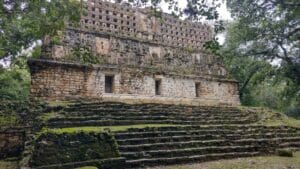
👆The distinctive structures of the Yaxchilán archaeological site
From the archaeological site to the jungle, you can experience another side of Mexico

In this region’s journey, you can explore the famous Mayan ruins like Palenque, Yaxchilan located in the southeast, and Bonampak. For those interested in Mesoamerican history, consider extending your trip to the Olmec region. The Olmecs were the earliest culture to develop in the area of present-day Mexico around 1800 BC, preceding the famous Maya culture. They built massive structures, practiced the worship of the “feathered serpent,” and had rulers, forming the foundations of the “first Mesoamerican culture.”
For nature enthusiasts looking for a different and unique travel experience, this route is highly recommended. The region around Palenque and Yaxchilan is known as the Lacandón Jungle, one of Mexico’s most diverse natural parks with abundant flora and fauna.
A Journey to the Unknown Lacandón
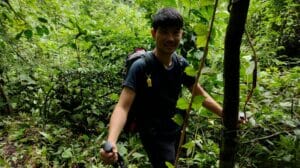
👆In the Heart of Lacandon Jungle
The name “Lacandón” is derived from the extinct Ch’olti Maya language, specifically from the term “Lacan-tún,” which means “rocky hill” or “hard rock.” It was a name given by a tribe of Yucatan Peninsula origin who formed settlements near Lake Miramar during the Maya period. The linguistic aspects of Mexico are complex, but understanding Mexican culture, especially the Maya culture, is crucial, and it becomes highly intriguing when you learn more about it. During your trip to the eastern part of Chiapas, we will provide detailed explanations about these languages, which will make your journey even more fascinating.
Just in the northern part of Lacandon Jungle alone, there are various Maya languages spoken in different villages and regions. For example, Ch’ol is spoken around Palenque and Yaxchilan, Maya-Lacandon is spoken near the Bonampak ruins, Tzeltal is spoken in the village of Palestina, and there are also Tojorabal, Tsotsil, and Chontal languages, each spoken in their respective communities. Despite belonging to the Maya language family, these languages are distinct from one another and are used as the first language in daily life in their respective areas.
On the other hand, some of these languages, like Maya-Lacandon, are facing the risk of extinction, which is a significant loss for Mexico’s cultural diversity. As your guide, I believe it’s essential to preserve and celebrate these invaluable aspects of Mexican culture.
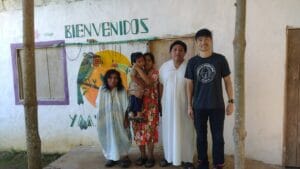
The Lacandón Jungle is home to an impressive diversity of wildlife, with a recorded count of 114 butterfly species, 345 mammal species, and around 3,400 plant species, of which approximately 160 are unique to this forest, making up 15% of Mexico’s entire vegetation. It serves as a vital habitat for endangered species such as the Tapir, Jaguar, and the beautiful Scarlet Macaw, also known as “Red Guacamaya” in Mexico. This pristine environment is truly a treasure trove of biodiversity.
Representative archaeological sites of the Classic Period of the Maya culture

👆Palenque Archaeological Site
The ancient city ruins, known as Palenque, designated as a UNESCO World Heritage Site, flourished during the Late Classic Period of the renowned Maya civilization. The history of Mesoamerica can be broadly divided into three periods, with the middle era known as the Classic Period, spanning from around AD 200 to AD 900. The Early Maya Period, occurring before AD 900, witnessed the formation of settlements in Mesoamerica’s Pre-Classic era, which goes from BC 3000 to AD 200. The subsequent development of major cities during the Classic Period, such as Calakmul, Tikal, and Palenque, experienced prosperity during the Late Classic Period from around 600 to 900 AD.
On the other hand, after AD 900, cities of the Late Maya Period, such as the well-known sites like Chichen Itza, Uxmal, and Tulum, thrived during the Post-Classic Period, which began from AD 900 and ended with the arrival of Spaniards. The Classic Period, during which Palenque flourished, is further divided into Early Classic and Late Classic periods, with Palenque’s significant development occurring during the latter from approximately 600 to 900 AD. However, the growth of a city was not sudden but rather required a long period of time to reach its pinnacle. The early formation of settlements in the region where Palenque’s ruins stand today began around 150 BC, and it was not until around AD 200 that the first colossal structures were constructed.
At that time, Palenque was not referred to as “Palenque” but was known by different names based on the local Maya Ch’ol language spoken in the area. In Ch’ol, it was called “Otulum,” which translates to “fortified house,” likely due to the strategic location of the city’s construction. It was also referred to as “Lakamha” in the Maya Yucatec language, used on the Yucatan Peninsula, meaning “place of abundant water,” as there were at least nine water sources in the vicinity. During the latter half of the Maya Period, Palenque wielded immense power. However, the decline of other major Earlier Maya Period cities like Tonina and Calakmul marked the beginning of a new era in Maya history, which is the era of the Later Maya Period.
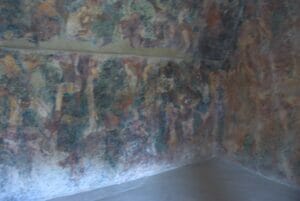
👆One of the three major surviving Mesoamerican murals: Bonampak
And then there’s the inaccessible archaeological site of Yaxchilan. Here, prosperity began around AD 200, roughly the same time when the early constructions of Palenque started. It reached its peak during the period of 600 to 800 AD, which corresponds to the height of Palenque’s splendor. In the Maya region, there are broadly 16 architectural styles, but Yaxchilan stands out with its unique Usumacinta style of construction, distinguishing it from nearby sites like Bonampak, Palenque, and Tonina.

Let’s spend a night in the Lacandón forest and immerse ourselves in nature.
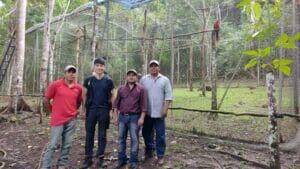
👆We will be guided by the Ch’ol people
Our tour is different from the typical day trip from Palenque. We highly recommend the route where you can spend one night in the Lacandón forest. The regular tours usually rush through Bonampak and Yaxchilán, spending around 6 hours round trip by car. However, our Lacandón tour is much more immersive. In the forest where mobile signals are scarce, and the internet doesn’t reach, you will spend a night listening to the “live” sounds of animals. The accommodation may not be “luxurious,” but being surrounded by 100% natural world of the Maya region makes it a more “luxurious” place than any lavish hotel or restaurant on Earth. The facility generates all its electricity from solar panels and charges batteries, and water is sourced from the abundant rainwater brought by the Usumacinta River, with hot water provided by solar heat. This ensures a nearly 100% sustainable experience in the Lacandón rainforest. We are also starting to provide meals using our self-grown crops little by little.
Then, the rainforest tour. It’s a real jungle tour that takes you through the rainforest for almost 2 hours, quietly observing wild birds and occasional glimpses of wildlife. Along the route, you will find untouched remnants of Maya-era structures. Additionally, the valuable experience of interacting with the local Ch’ol people will be something to cherish. It’s a brief moment to glimpse their traditions and customs, something that rarely comes to the surface, but it will undoubtedly be a memorable experience.
If you desire, we can make a stop at a village on the Guatemala side on the way back. There may not be any particular tourist attractions there, but the unique experience of crossing into another country with just one step is something you won’t encounter in other places, making it an interesting addition to your journey.
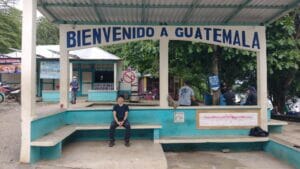
※ The number of places we can visit will depend on the duration of your stay, so please feel free to consult with us about your itinerary. We will be flexible in scheduling according to your available time, so don’t hesitate to discuss your preferences with us.
Especially recommended for
- Those who seek excitement and thrill
- Those who want to experience the authentic side of Mexico
- Those who wish to turn their travel time into a journey of exploration
- Travelers who feel unsatisfied with typical tour packages
- Groups of female travelers
- Travelers with abundant physical stamina
- Those who desire a special and unique trip to Mexico
- People who have a love for culture and nature
- Anyone, regardless of age or gender, seeking a memorable experience
Everyone, regardless of their background or interests, is warmly welcomed!